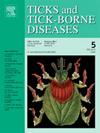Linked empirical studies reveal the cumulative impact of acquired tick resistance across the tick life cycle
IF 3.4
2区 医学
Q2 INFECTIOUS DISEASES
引用次数: 0
Abstract
Host defenses affect tick feeding success, and thus survival and reproduction, but defensive traits have rarely been studied relative to tick population dynamics. We explored the effects of anti-tick resistance of three natural hosts against Dermacentor andersoni, the Rocky Mountain wood tick. Larval ticks were fed on Deer mice (Peromyscus maniculatus) and Cottontail rabbits (Sylvilagus nuttallii), and nymph and adult ticks were fed on cattle (Bos taurus). We compared feeding success and fecundity of ticks fed on naïve (never infested by ticks) or exposed (one prior tick infestation) hosts. We used these measures to parameterize simulations of D. andersoni population growth in a discrete time, geometric population model to understand the population-level consequences of anti-tick resistance. Prior infestation triggered tick resistance in all three host species and impacted all tick life stages. On tick-exposed hosts, an average of 23 % fewer ticks reached adulthood and adult females produced 32 % fewer larvae. Modest effects of tick resistance at each life stage had strong cumulative effects across the tick life cycle. Simulated tick population dynamics revealed that mean population growth () is reduced 68 % when the life cycle is completed on hosts with prior tick exposure. Simulated populations feeding on exposed hosts were more likely to decline (<1) under conditions of low off-host survival and host-finding. This suggests acquired tick resistance may interact with environmental conditions and host availability to affect tick population dynamics. These data shed new light on naturally occurring biotic factors that may affect tick abundance and tick-borne pathogen transmission.
相关的实证研究揭示了获得性蜱虫抗性在整个蜱虫生命周期中的累积影响。
寄主防御影响蜱的捕食成功,从而影响生存和繁殖,但防御特性很少与蜱种群动态有关。研究了三种天然寄主对落基山木蜱的抗蜱抗性效果。蜱幼虫以鹿鼠(Peromyscus maniculatus)和兔(Sylvilagus nuttallii)为食,蜱若虫和成蜱以牛(Bos taurus)为食。我们比较了蜱虫在naïve(从未被蜱虫感染)和暴露(一次蜱虫感染)宿主上的取食成功率和繁殖能力。我们使用这些方法在离散时间几何种群模型中对安德氏蜱种群增长进行参数化模拟,以了解抗蜱药对种群水平的影响。先前的侵染引发了所有三种宿主物种的蜱抗性,并影响了蜱的所有生命阶段。在暴露于蜱虫的宿主上,达到成年期的蜱虫平均减少23%,成年雌蜱产生的幼虫平均减少32%。蜱虫抗性在每个生命阶段的影响不大,但在整个生命周期中具有较强的累积效应。模拟的蜱虫种群动态显示,当宿主的生命周期结束时,以前的蜱虫暴露在宿主上,平均种群增长(λ)减少68%。以暴露的宿主为食的模拟种群更有可能下降(λ)
本文章由计算机程序翻译,如有差异,请以英文原文为准。
求助全文
约1分钟内获得全文
求助全文
来源期刊

Ticks and Tick-borne Diseases
INFECTIOUS DISEASES-MICROBIOLOGY
CiteScore
6.90
自引率
12.50%
发文量
185
审稿时长
6-12 weeks
期刊介绍:
Ticks and Tick-borne Diseases is an international, peer-reviewed scientific journal. It publishes original research papers, short communications, state-of-the-art mini-reviews, letters to the editor, clinical-case studies, announcements of pertinent international meetings, and editorials.
The journal covers a broad spectrum and brings together various disciplines, for example, zoology, microbiology, molecular biology, genetics, mathematical modelling, veterinary and human medicine. Multidisciplinary approaches and the use of conventional and novel methods/methodologies (in the field and in the laboratory) are crucial for deeper understanding of the natural processes and human behaviour/activities that result in human or animal diseases and in economic effects of ticks and tick-borne pathogens. Such understanding is essential for management of tick populations and tick-borne diseases in an effective and environmentally acceptable manner.
 求助内容:
求助内容: 应助结果提醒方式:
应助结果提醒方式:


